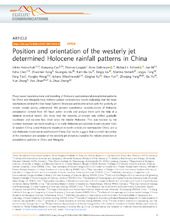Position and orientation of the westerly jet determined Holocene rainfall patterns in China
| dc.contributor.author | Herzschuh, Ulrike | |
| dc.contributor.author | Cao, Xianyong | |
| dc.contributor.author | Laepple, Thomas | |
| dc.contributor.author | Dallmeyer, Anne | |
| dc.contributor.author | Telford, Richard | |
| dc.contributor.author | Ni, Jian | |
| dc.contributor.author | Chen, Fahu | |
| dc.contributor.author | Kong, Zhaochen | |
| dc.contributor.author | Liu, Guangxui | |
| dc.contributor.author | Liu, Kam-Bui | |
| dc.contributor.author | Liu, Xingqi | |
| dc.contributor.author | Stebich, Martina | |
| dc.contributor.author | Tang, Lingyu | |
| dc.contributor.author | Tian, Fang | |
| dc.contributor.author | Wang, Yongbo | |
| dc.contributor.author | Wischnewski, Juliane | |
| dc.contributor.author | Xu, Qinghai | |
| dc.contributor.author | Yan, Shun | |
| dc.contributor.author | Yang, Zhenjing | |
| dc.contributor.author | Yu, Ge | |
| dc.contributor.author | Zhang, Yun | |
| dc.contributor.author | Zhao, Yan | |
| dc.contributor.author | Zheng, Zhuo | |
| dc.date.accessioned | 2020-05-13T14:49:07Z | |
| dc.date.available | 2020-05-13T14:49:07Z | |
| dc.date.issued | 2019-05-30 | |
| dc.Published | Herzschuh U, Cao X, Laepple T, Dallmeyer, Telford R, Ni J, Chen F, Kong, Liu, Liu, Liu X, Stebich M, Tang, Tian F, Wang Y, Wischnewski J, Xu Q, Yan, Yang, Yu G, Zhang Y, Zhao Y, Zheng Z. Position and orientation of the westerly jet determined Holocene rainfall patterns in China. Nature Communications. 2019;10:2376 | eng |
| dc.identifier.issn | 2041-1723 | en_US |
| dc.identifier.uri | http://hdl.handle.net/1956/22245 | |
| dc.description.abstract | Proxy-based reconstructions and modeling of Holocene spatiotemporal precipitation patterns for China and Mongolia have hitherto yielded contradictory results indicating that the basic mechanisms behind the East Asian Summer Monsoon and its interaction with the westerly jet stream remain poorly understood. We present quantitative reconstructions of Holocene precipitation derived from 101 fossil pollen records and analyse them with the help of a minimal empirical model. We show that the westerly jet-stream axis shifted gradually southward and became less tilted since the middle Holocene. This was tracked by the summer monsoon rain band resulting in an early-Holocene precipitation maximum over most of western China, a mid-Holocene maximum in north-central and northeastern China, and a late-Holocene maximum in southeastern China. Our results suggest that a correct simulation of the orientation and position of the westerly jet stream is crucial to the reliable prediction of precipitation patterns in China and Mongolia. | en_US |
| dc.language.iso | eng | eng |
| dc.publisher | Nature Research | en_US |
| dc.rights | Attribution CC BY | eng |
| dc.rights.uri | http://creativecommons.org/licenses/by/4.0/ | eng |
| dc.title | Position and orientation of the westerly jet determined Holocene rainfall patterns in China | en_US |
| dc.type | Peer reviewed | |
| dc.type | Journal article | |
| dc.date.updated | 2019-11-15T11:21:31Z | |
| dc.description.version | publishedVersion | en_US |
| dc.rights.holder | Copyright 2019 The Author(s) | en_US |
| dc.identifier.doi | https://doi.org/10.1038/s41467-019-09866-8 | |
| dc.identifier.cristin | 1729840 | |
| dc.source.journal | Nature Communications |

